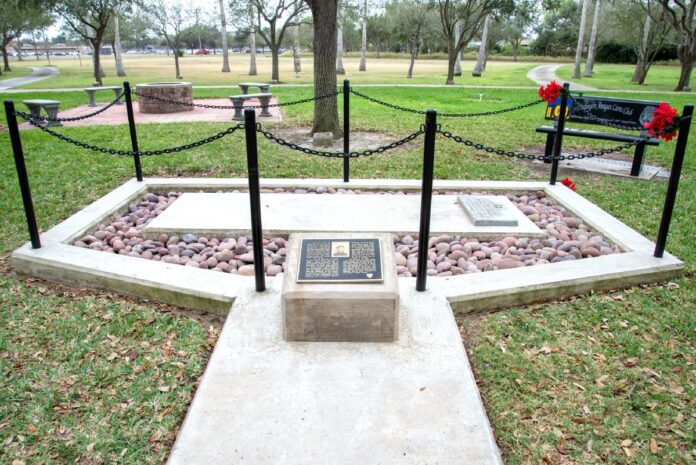HARLINGEN — Walter Fleming remembers only too well his five days on Iwo Jima.
“I was in a Higgins vehicle evacuating wounded off the beach,” said Fleming, 91, who will attend the 75th Anniversary Iwo Jima Memorial Parade on Wednesday at Marine Military Academy.
The anniversary commemorates a crucial World War II battle in the Pacific to wrestle the strategic island of Iwo Jima from the Japanese. The horrific assault began on Feb. 19, 1945, when 110,000 U.S. Marines disembarking from 880 ships began their ground assault on the island. Fleming, who lives in New Braunfels, was only 16 years old at the time.
They found themselves sinking in sand and volcanic ash, said Gloria Boling, director of the Iwo Jima Museum Gift Shop at Marine Military Academy.
“They got there and didn’t realize that they were not going to be able to fight like they did at the other islands because of the sand or the ash and the fact that the Japanese were buried in the caves,” she said. “They couldn’t see all that from the ships, so as soon as they were coming off the ships they were getting killed.”
Two of those Marines were Harlon Block and Glen Cleckler of Weslaco. The two seniors at Weslaco High School had decided to skip school with several others and, through a strange turn of events, ended up joining the Marine Corps. Block ultimately became one of the flag raisers in the iconic photograph shot by Associated Press Photographer Joe Rosenthal. He was later killed, and he’s buried near the Iwo Jima Memorial at MMA. Cleckler, who later became a Harlingen school teacher, visited the grave often throughout his life.
The Marines and Navy Corpsmen persevered in spite of casualties — 26,000 American casualties, including 6,800 dead — out of a sense of duty to one another and the crucial task at hand. Many of them had fought to take Guam, Tinian and Saipan in the Marianas Islands in the summer of 1944, and American Seabees had quickly built or rebuilt airfields.
Fleets of B-29 SuperFortress bombers soon began taking off from the Marianas for bombing runs over Japan.
Halfway there, however, they encountered a tiny island with a big attitude: Iwo Jima. A half-hour video at the Iwo Jima Museum explains the situation in detail. Japan had hundreds of fighter planes based on Iwo Jima on two airfields and a third under construction.
“The Japanese fighters consistently attacked the B29s, knocking down many and severely damaging others to the point that it was impossible for them to return to their bases,” says the film’s narrator.
On top of that, the Japanese on Iwo Jima maintained a sophisticated communications system. After the Japanese forces on Iwo Jima finished their attacks on the B-29s, they’d radio ahead to Japan and let them know the bombers were coming.
“This allowed the enemy anti-aircraft guns to ready themselves,” the narrator says. “It also allowed the Japanese fighter planes to ready themselves to down or severely damage even more of the bombers.”
Yes, taking Iwo Jima was vital, and the Marines knew it. When they arrived on the beach, however, there was no enemy fire. They wondered if the extensive bombing of the island by Allied forces had neutralized the enemy.
What they didn’t know was that the 23,000 Japanese troops under Gen. Tadamichi Kuribayasha had spent months creating a system of tunnels and catacombs deep into the solid rock. From small holes leading to their fortified protections they suddenly opened fire, mowing down thousands of troops.
Marines had to dig holes for themselves and use flame throwers and hand grenades to route Japanese troops.
Fleming recalls the first five days of the battle. He was the coxswain, or boat captain, of a Higgins amphibious landing craft.
“I made eight landings the first day carrying wounded off the beach,” he said. “There were so many of them had been hit.”
Photographs of the initial days show scores of destroyed vehicles along the shore, many of them other Higgins vehicles around which Fleming had to navigate under heavy fire.
“One time when I picked up a load of wounded I backed up into a sunk boat and I got the ramp cable wrapped around my screw,” he said. “It killed my engine three times.”
A young ensign wanted to get off the boat and head for cover, but Fleming wouldn’t hear of it. He had wounded who needed medical care. He was able to get the boat moving again, and he transported the men back to his ship.
He ended up making more runs in those five days than any other boat captain and was given a citation for courage under fire.
“All the men were under fire,” he emphasized.
But all the men weren’t 16 years old like he was. He had nightmares about the experience for years to come, and didn’t talk about it until recently.




